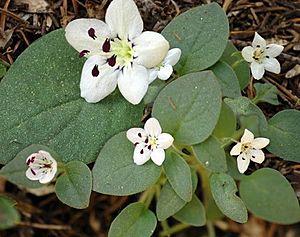Scott Mountain phacelia facts for kids
Quick facts for kids Scott Mountain phacelia |
|
|---|---|
 |
|
| Scientific classification | |
| Kingdom: | |
| (unranked): | |
| (unranked): | |
| (unranked): | |
| Order: |
(unplaced)
|
| Family: | |
| Genus: |
Howellanthus
|
| Species: |
H. dalesianus
|
| Binomial name | |
| Howellanthus dalesianus J.T.Howell
|
|
Howellanthus is a special kind of flowering plant. It belongs to the borage family. There is only one species in this group, called Howellanthus dalesianus. People often call it the Scott Mountain phacelia or Howell's phacelia.
Before 2010, this plant was known by a different name, Phacelia dalesiana. It grows only in a specific area: the southern Klamath Mountains in northern California. It's even named after the Scott Mountains where it lives! You can find it growing in mountain forests and open meadows.
What Does It Look Like?
The Scott Mountain phacelia is a plant that lives for many years. It grows a few stems that lie close to the ground. These stems can be up to about 15 centimeters (about 6 inches) long. They spread out to form a small patch.
The plant feels a bit sticky and hairy. It has special glands that make it sticky. Its main leaves grow in a circle close to the ground, like a rosette. There are also a few smaller leaves along its stems. These leaves are oval-shaped and have smooth edges.
Its Flowers
The flowers of the Scott Mountain phacelia grow in a small, curved cluster. Each flower is less than a centimeter (about 0.4 inches) wide. They are white with tiny purple stripes inside, near the center.
Each flower has five stamens that stick out. Stamens are the parts of a flower that make pollen. The tips of these stamens have large purple anthers. The plant blooms between May and August. The exact time it flowers depends on when the snow melts in the mountains.
Where Does It Live?
The Scott Mountain phacelia is a very old and unique plant. Scientists call it a "paleoendemic." This means it's a plant that has been around for a very long time. Its shape and features are different from other plants in the phacelia group.
It likely survived in areas with special "ultramafic" rocks. These rocks are found in a small part of the Siskiyou-Trinity Mountains. The plant is a "relict," meaning it's a leftover from a time when its relatives might have been more widespread.
How It Got Its Name
The plant's new name, Howellanthus, honors a botanist named John Thomas Howell. The second part of its scientific name, dalesianus, honors his friend, Ella Dales Miles Cantelow. She was a plant collector.
The first place this plant was officially found and described is called the "type location." This spot is at the top of Scott Mountain in Trinity County, California. It's close to California State Route 3 and the Pacific Crest Trail. Many other rare plants were first discovered in this same area.

